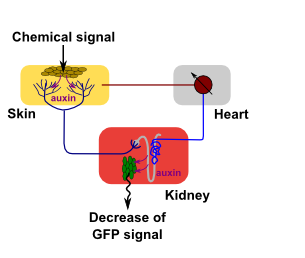Team:Evry/Promoters
From 2012.igem.org
(Difference between revisions)
PierreYves (Talk | contribs) |
|||
| Line 7: | Line 7: | ||
| - | <img src="https://static.igem.org/mediawiki/2012/4/49/T.gif" alt="transcription factor" width=" | + | <img src="https://static.igem.org/mediawiki/2012/4/49/T.gif" alt="transcription factor" width="200px" align="right"/> |
Promoters have been defined as modulatory DNA structures, regulatoring initiation of transcription | Promoters have been defined as modulatory DNA structures, regulatoring initiation of transcription | ||
Revision as of 17:04, 22 September 2012
Promoters
What's a Promoter?
 Promoters have been defined as modulatory DNA structures, regulatoring initiation of transcription
and for controlling expression of a gene. Promoters therefore induce, via protein synthesis, the specific role of tissue.
Indeed, the promoter is the region of the DNA where binds initially RNA polymerase before the start of RNA synthesis. This sequences are generally located upstream of the start site of transcription. Fixation and activation of RNA polymerase is controlled by transcription factors which may be either activators or repressors of transcription.
Promoters have been defined as modulatory DNA structures, regulatoring initiation of transcription
and for controlling expression of a gene. Promoters therefore induce, via protein synthesis, the specific role of tissue.
Indeed, the promoter is the region of the DNA where binds initially RNA polymerase before the start of RNA synthesis. This sequences are generally located upstream of the start site of transcription. Fixation and activation of RNA polymerase is controlled by transcription factors which may be either activators or repressors of transcription.
The organization of promoter sequences in the eukaryotes:

Our Promoters Sytem
Specific Skeletal Muscle Expression

Pancreas Expression

Anti Heat-Shock System

----------------------
pCS2+ with RFP J04450
pCS2+ carracteristic
pCS2+, plasmid of 4095pb, contains :- AmpR : An Ampicilin resistance gène ( link to sequence )
- ColE1 ori : Transcription and initiation of DNA replication in E.Coli
- F1 origin : Replication Origin
- Simian CMV IE94 Promoter : CMV eukariotic promoter to increase the transcription plasmid
- M13 R :
- lac operon :
- T3 promoter frag
- SV40 polyA :
- B-globin 5' mRNA sequence :
- Sp6 :
- T7 promoter frag :
 "
"
